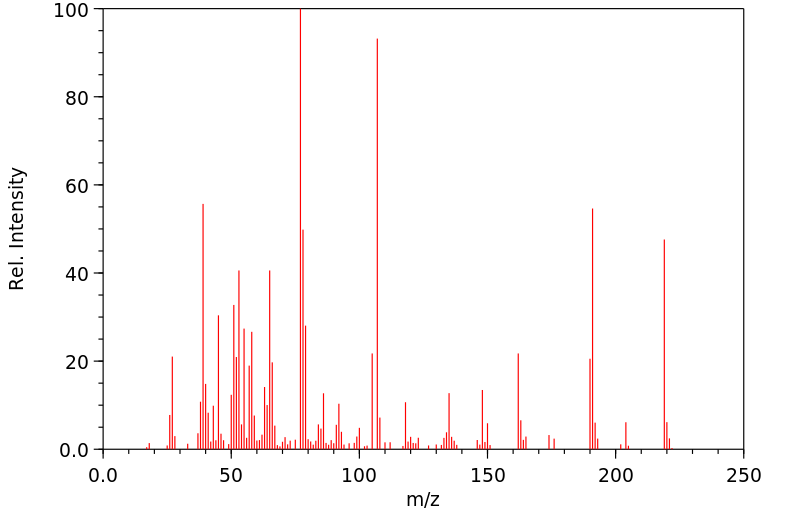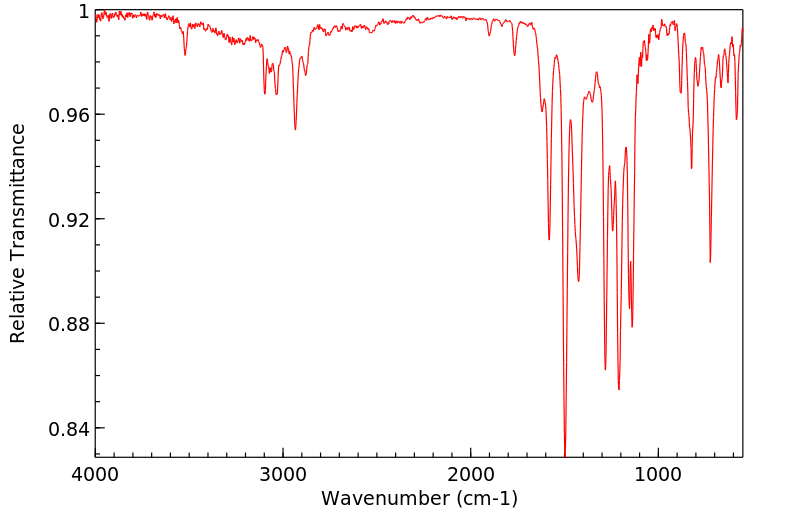2-(2-噻唑基偶氮)对甲酚 | 1823-44-5
中文名称
2-(2-噻唑基偶氮)对甲酚
中文别名
4-甲基-2-(2-噻唑基氮)苯酚;2-(2'-噻唑基偶氮)对甲酚;2-(2-噻唑基偶氮)对甲苯酚;2-(2"-噻唑基偶氮)对甲酚
英文名称
2-(2-thiazolylazo)-p-cresol
英文别名
2-(2-Thiazolylazo)-4-methyl-phenol;TAC;4-methyl-2-(1,3-thiazol-2-yldiazenyl)phenol
CAS
1823-44-5
化学式
C10H9N3OS
mdl
MFCD00005323
分子量
219.267
InChiKey
MZRKINSTWYZJLV-UHFFFAOYSA-N
BEILSTEIN
——
EINECS
——
-
物化性质
-
计算性质
-
ADMET
-
安全信息
-
SDS
-
制备方法与用途
-
上下游信息
-
文献信息
-
表征谱图
-
同类化合物
-
相关功能分类
-
相关结构分类
物化性质
-
熔点:130-132 °C(lit.)
-
沸点:392.6±52.0 °C(Predicted)
-
密度:1.35±0.1 g/cm3(Predicted)
-
溶解度:可溶50mg/mL,澄清,红色至红棕色(乙醇:CHCl3 (1:1))
-
稳定性/保质期:
如果按照规格正确使用和储存,则不会发生分解,目前未有已知危险。
计算性质
-
辛醇/水分配系数(LogP):3.1
-
重原子数:15
-
可旋转键数:2
-
环数:2.0
-
sp3杂化的碳原子比例:0.1
-
拓扑面积:86.1
-
氢给体数:1
-
氢受体数:5
安全信息
-
危险品标志:Xi
-
危险类别码:R36/37/38
-
WGK Germany:3
-
海关编码:2934100090
-
安全说明:S26,S36
-
危险标志:GHS07
-
危险性描述:H315,H319,H335
-
危险性防范说明:P261,P305 + P351 + P338
-
储存条件:密封保存
SDS
制备方法与用途
制备方法
主要用于有机合成。
用途简介暂无内容。
用途主要用于有机合成。
反应信息
-
作为反应物:描述:参考文献:名称:Planar triazinium cations from vanadyl-mediated ring cyclizations: the thiazole species for efficient nuclear staining and photocytotoxicity摘要:通过1-(2-噻唑偶氮)-2-萘酚(H-TAN,1)、1-(2-吡啶偶氮)-2-萘酚(H-PAN,2)、2-(2'-噻唑偶氮)-对甲酚(H-TAC,3)和6-(2'-噻唑偶氮)-间苯二酚(H-TAR,5)的钒辅助环化反应,制备并表征了平面三嗪阳离子物种。还分离得到了一种二氧钒(V)物种[VO2(TAR)](4)。化合物1、2和4进行了结构表征。1和2均具有平面结构,复合物4具有VVO3N2配位几何结构。环化的三嗪化合物在DMF-0.1 M四丁基高氯酸铵中形成自由基物种,电位范围为-0.06至-0.29 V vs. SCE,并由于阴离子物种的形成而产生第二个响应。共聚焦显微镜研究表明,与具有 fused 吡啶环的2相比,具有 fused 噻唑基团的1具有更高的细胞核摄取。这些化合物显示出与小牛胸腺DNA的部分嵌插结合模式。在氩气气氛下,化合物1在波长400-700 nm的可见光下表现出质粒DNA光裂解活性,对HeLa和MCF-7细胞分别具有15.1和3.4 μM的IC50值,而在暗处基本无毒,IC50值分别为90.4和21.9 μM。通过TDDFT研究合理化了实验数据。DOI:10.1039/c2dt32810k
-
作为产物:参考文献:名称:TiCl3/HBr体系促进偶氮衍生物的催化氧化摘要:通过具有普遍合成意义的新型催化过程,可以有效且选择性地将偶氮化合物转化为相应的偶氮衍生物。该过程的拟议机制包括两个独立且独特的催化循环,通过自由基物种连接在一起。第一个循环包括由 H2O2 的 Ti(III) 单电子还原产生的羟基自由基的形成。在第二个循环中,羟基自由基将 HBr 氧化成次溴酸,而次溴酸又被偶氮底物还原回 HBr 和水。DOI:10.1021/ja074413c
文献信息
-
一种混合偶氮苯配体的钴配合物及其制备方法申请人:广西大学公开号:CN106749426A公开(公告)日:2017-05-31
-
Cobalt metal-mixed organic complex-based hybrid micromaterials: ratiometric detection of cyanide作者:Hai-Bo Liu、He-Song Han、Bin Lan、Dong-Mei Xiao、Jing Liang、Zi-Ying Zhang、Jing WangDOI:10.1039/c8ra00079d日期:——
A cobalt metal-mixed organic complex-based hybrid micromaterial has been presented to detect CN− with ratiometric absorption responses (
A 456 nm/A 537 nm). -
Ruthenium(II) NNO pincer type catalyst for the conversion of aldehydes to amides作者:Nandhagopal Raja、Mathiyazhagan Ulaganatha Raja、Rengan RameshDOI:10.1016/j.inoche.2012.01.035日期:2012.5[RuHCl(CO)(PPh3)3] and 2-(2-thiazolylazo) cresol ligand (TAC) in benzene under reflux afforded a new pincer type ruthenium(II) carbonyl complex containing thiazolylazo cresol of general formula [RuCl(CO)(PPh3)(TAC)] (TAC = mono anionic NNO donor). The complex has been characterized by elemental analyses, FT-IR, UV–Vis, and 1H NMR spectral methods. The crystal structure of the complex [RuCl(CO)(PPh3)(TAC)]
-
Selective H2PO4− anion sensing by two neutral Zn2+ complexes and combined theoretical and experimental studies of their structural and spectral properties作者:Amar Hens、Pallab Mondal、Kajal Krishna RajakDOI:10.1016/j.poly.2014.08.024日期:2015.1thiazole and substituted phenol moieties with Zn2+ in a 1:2 (M:HL) molar proportion in methanol at ambient condition afforded complexes of the composition [Zn(L)2] in excellent yields. Here L is the deprotonated form of 2-(2-thiazolylazo)-p-cresol (HL1) and 4-(2-thiazolylazo)-resorcinol (HL2). Their detailed optical properties have been investigated experimentally and theoretically. The mechanism of摘要在环境条件下,甲醇中摩尔比为1:2(M:HL)的具有偶氮核并有噻唑和取代酚部分与Zn2 +结合的偶氮酚基受体(HL)在甲醇中反应,形成了[Zn( L)2]。这里L是2-(2-噻唑基)-对甲酚(HL1)和4-(2-噻唑基)-间苯二酚(HL2)的去质子化形式。已通过实验和理论研究了它们的详细光学性质。金属-配体相互作用的机理已通过吸收和发射光谱实验确定,证实了Zn2 +离子与配体部分的良好配位,导致形成两个1:2的五元螯合环(M: L)配合物。两种复合物在室温下,随着丙酮水溶液(4:1 v / v)(pH 7.4,0.01 M HEPES)中H2PO4-(Pi)阴离子浓度的增加,对降低荧光强度的特性均显示出显着的选择性。温度。DFT和TDDFT计算表明,ICT过程从对甲酚环(供体,HOMO)到噻唑和偶氮部分(受体,LUMO),在Zn2 +和配体之间的络合过程中通过CHEF机制增强了荧光强度。
-
Methoxido‐Bridged Lacunary Heterocubane Oxidovanadium(IV) Cluster with Azo Ligands: Synthesis, X‐ray Structure, Magnetic Properties, and Antiproliferative Activity作者:Satabdi Roy、Michael Böhme、Sudhir Lima、Monalisa Mohanty、Atanu Banerjee、Axel Buchholz、Winfried Plass、Sharan Rathnam、Indranil Banerjee、Werner Kaminsky、Rupam DindaDOI:10.1002/ejic.202200109日期:2022.7.27Two thiazolyl based μ3-methoxido bridged trinuclear vanadium(IV) arylazo complexes are described. Magnetic susceptibility measurements show an antiferromagnetic coupling between the three vanadium(IV) centers mediated by the μ2-OMe co-ligands, consistent with the syn-coplanar bridging mode, as revealed by spin-density analyses. In vitro cytotoxicity results of the complexes were promising against HeLa
表征谱图
-
氢谱1HNMR
-
质谱MS
-
碳谱13CNMR
-
红外IR
-
拉曼Raman
-
峰位数据
-
峰位匹配
-
表征信息
同类化合物
(2-氯-6-羟基苯基)硼酸
黄柄曲菌素
高香草酸-d3
高香草酸-13C6
高香草酸
高香兰酸乙酯
高辣椒素II
高二氢辣椒素I
香草醛醛肟
香草醛苯腙
香草醛-甲氧基-13C
香草醛-(N-对甲苯基肟)
香草醛
香草酸肼
香草壬酰胺
香草基扁桃酸乙酯
香草吗啉
香草二乙胺
香兰素胺硬脂酸盐
香兰素胺硬脂酸盐
香兰素胺盐酸盐
香兰素丙二醇缩醛
香兰素13C6
香兰素-D3
香兰基乙基醚
香兰基丁醚
顺式-5-正十五碳-8'-烯基间苯二酚
顺式-1-(2-羟基-5-甲基苯基)-2-丁烯-1-酮
顺式-1-(2-羟基-4-甲氧基苯基)-2-丁烯-1-酮
顺-3-氯二氢-5-苯基呋喃-2(3H)-酮
雌二醇杂质1
降二氢辣椒碱
阿诺洛尔
阿瓦醇
阿普斯特杂质
间苯二酚双(二苯基磷酸酯)
间苯二酚-烯丙醇聚合物
间苯二酚-D6
间苯二酚
间苯三酚甲醛
间苯三酚二水合物
间苯三酚
间羟基苯乙基溴
间硝基苯酚
间甲酚紫钠盐
间甲酚与对甲酚和苯酚甲醛树脂的聚合物
间甲酚-D7
间甲酚-D3
间甲酚
间溴苯酚








